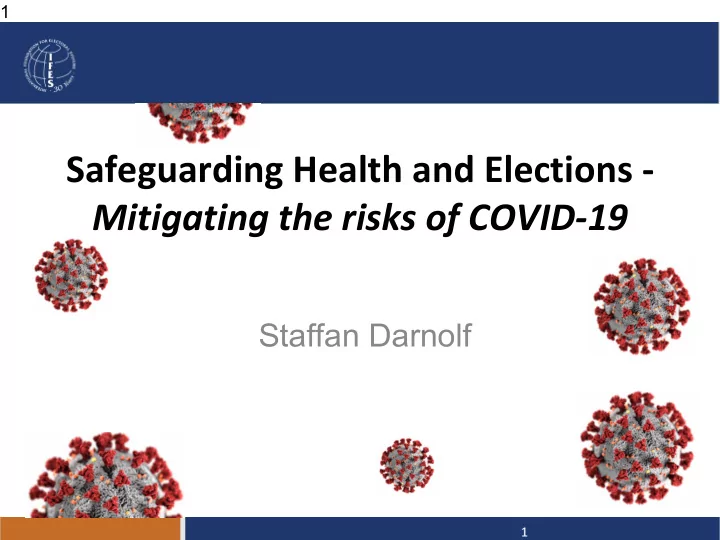

1 Safeguarding Health and Elections - Mitigating the risks of COVID-19 Staffan Darnolf
2 Introduction
3 Introduction COVID-19 – Background Information Modes of Transmission • Direct – person to person via respiratory droplets • Indirect – via fomites (contaminated objects and surfaces
EMB’s Fundamental & Early Tasks 4 Introduction 1) Conduct joint public health risk assessment 2) Develop risk-mitigation plan with necessary changes to regulations and procedures, additional material, legal amendments. Develop an outreach plan. 3) Integrate the mitigation plan into an updated EMB operational plan , revise election calendar and budget.
Activity-Specific Recommendations 5 Introduction Phase I: Pre-Electoral Activities Electoral Campaign Provide risk-mitigation instructions for • public rallies, debates, and other gatherings Streamline messaging with political • parties, candidates, civil society organizations, and media Adopt or expand access to the media and • other methods for remote campaign fairly Detect and sanction actors using COVID- • 19-related disinformation for political gains Develop code of conduct •
Activity-Specific Recommendations 6 Introduction Phase I: Pre-Electoral Activities Voter Ed & Strategic Comms About COVID-19 and about new electoral • procedures and how to comply with them Address disease-related disinformation and • hate speech against vulnerable or marginalized groups Best practices in health literacy: Limited number of messages - One idea at a time, no more than three or four instructions What to do rather than not do – Active voice and positive tone Choosing words – Short sentences, simple or familiar words, culturally appropriate. Selecting visuals – Font and size easy to read, images illustrate desired health-related behavior. High resolution to allow for large prints, culturally relevant and sensitive.
Activity-Specific Recommendations 7 Introduction Phase I: Pre-Electoral Activities Poll Worker, Observers, and Other Poll Worker, Observer, and Other Staff Staff Recruitment Training Recruit and train more poll workers • Accessible virtual platforms for training • to replace potential dropouts with attention-checkers Accessible virtual platforms for • Large facilities allowing for distance • recruitment Hand sanitization • Release healthcare workers and at- • COVID-19 info incorporated to material • risk groups New procedures incorporated to material •
Activity-Specific Recommendations 8 Introduction Phase I: Pre-Electoral Activities Voter Registration, Candidate Registration, Ballot Casting Location - large to allow for physical distance; • far from at-risk groups, natural ventilation Layout – desks, chairs respecting distance; • remove unnecessary objects Number of voters – reduce number of people • at the same place at a time (expand number of days, assign groups to slots) Queue control and building entry and exit • protocols – design path for citizens from queue to exit, sanitizing hands before and after vote
Activity-Specific Recommendations 9 Introduction Phase I: Pre-Electoral Activities Voter Registration, Candidate Registration, Ballot Casting (Cont.) Educational material – displayed in all • polling stations Shared items – encourage citizens to bring • personal pens, provide disposable ones, or sanitize after each voter Protocol for voter verification – touchless • verification of ID Sanitization of equipment – contact • manufacturers for instructions Waste – appropriate collection and disposal •
Activity-Specific Recommendations 10 Introduction Phase I: Pre-Electoral Activities Voter Registration, Candidate Registration, Ballot Casting (Remote Options) Ensure inclusivity and accessibility of • online/remote options – internet penetration, content accessible to persons with disabilities, user friendliness Mail-in forms and ballots – use self- • sealing envelopes, sanitize hands after handling
11 Activity-Specific Recommendations Introduction Phase II: Election-Day Activities and Post-Electoral Processes Vote Count and Results Management Layout – desk space following distance requirements Party agents and observers – observe the count of each vote from a distance, as poll workers show each ballot Signing of tally sheets – signers take turn, use own pens Transportation and processing – use of PPE
12 Introduction Conclusions Safe and credible elections during COVID-19 are possible, but • they depend on a number of factors, including: o Status of disease transmission in the country (number of cases, trajectory of transmission) and capacity of healthcare system o Successful coordination with health authorities (for accuracy of information, optimal decision-making, and streamlined communication) o Effective communication with stakeholders to 1) make them confident in the safety of the process and 2) instruct them on how to effectively mitigate risks o Capacity to procure necessary materials and supplies, implement new processes, and establish new procedures o Capacity to implement and enforce new procedures on time o Capacity to maintain levels of citizen participation
Recommend
More recommend